Renaissance Armies: The Spanish
An article by George Gush
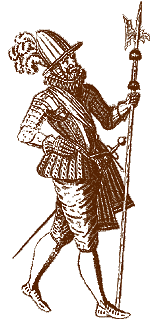
Spanish officer of the later 16th Century, probably around 1580
|
 Spain was very definitely the dominant military power of 16th Century Europe, primarily because her troops were the only real regulars west of the Ottoman Empire—regular, that is, in the sense that they alone were permanently employed, since Spain was permanently at war. Spanish forces alone provided anything like a proper career-structure for officers, for the same reason, and, partly for this reason, enjoyed the best generalship of the period. Spanish armies of the 16th Century acted as models and training schools for many others. Spain was very definitely the dominant military power of 16th Century Europe, primarily because her troops were the only real regulars west of the Ottoman Empire—regular, that is, in the sense that they alone were permanently employed, since Spain was permanently at war. Spanish forces alone provided anything like a proper career-structure for officers, for the same reason, and, partly for this reason, enjoyed the best generalship of the period. Spanish armies of the 16th Century acted as models and training schools for many others.
Spanish commitments were as great as Spanish wealth, and her troops fought in Spain itself, Oran and Tripoli, Italy, Ireland, France, Central and South America, and above all, in the Low Countries, which were under Spanish control from 1519. Under Charles V (1519-58), Spain and the Holy Roman Empire were temporarily united, and even into the 17th Century Spanish forces co-operated with Imperial ones; Franco-Dutch-Spanish conflict was renewed through the 30 Years War period. However, by this time, the economic and political decline of Spain was sapping the strength and morale of her troops, and their deterioration was highlighted by the disaster of Rocroi (1643), a defeat at French hands from which Spanish military power never recovered.
Their Catholic Majesties, Ferdinand of Aragon and Isabella of Castille, undertook a thorough reorganization of the rather heterogeneous forces of their newly-united kingdom at the end of the 15th Century, and it was from this that the 16th Century Spanish army sprang.
The main force for home defense and the support of the Civil Power was the militia of the fortified cities, the Hermanadad (Brotherhood), which included both cavalry and infantry. It was reorganized into battalions of ten 50 man companies each, those of Andalusia (1490) having seven percent with firearms, 33 percent crossbowmen, 42 percent spearmen or pikemen, and the rest pioneers and craftsmen. A sort of uniform was worn, consisting of a white woolen over-tunic with a hood, sleeves tight at the top but flaring out widely from the elbow, and a red cross back and front. Trousers (probably tight hose) were also red; boots or sandals were worn. Helmets were commonly of sallet type, much favored in Spain (and, indeed, generally) at this time. Provincial militia served throughout the period, mainly against rebellions—in 1567 they were one-third crossbowmen, two-thirds arquebusiers, while the cavalry had lances.
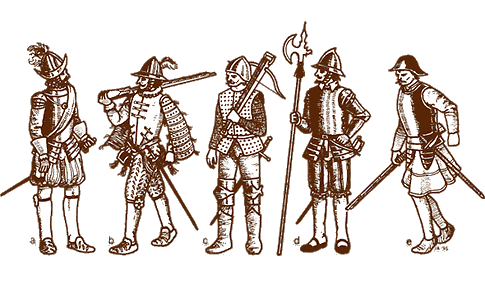
a. Officer, late 16th or early 17th Century, wearing half armour, ornate morion with plumes probably red-white-red, and red sash and holding a rapier, b. Late 16th or early 17th Century arquebusier wearing morion, hanging sleeves and knee-length baggy trousers. Note tasseled pouches and match on belt, c. Crossbowman, late 15th or early 16th Century. He wears tight hose, studded brigantine with mail sleeves, sallet helmet, plate protection at knees and Moorish boots. Pikemen, swordsmen and arquebusiers could be similar, d. Sergeant of a Tercio, 1534. Pikemen would be similar. e. Arquebusier in sallet, corselets and short tassets, early 16th Century. He wears a long-skirted tunic over hose and soft shoes, and could have had shoulder and elbow protection as well, or no armour at all. Again, pikemen could be similar.
A standing army under fuller royal control was started in the 1490s with Gendarmerie (see below) and Constabulary "of the Ordinance", on Burgundian lines. The latter were infantry, formed in 100 man companies, and probably similar to the Hermanadad troops in appearance. One-third were pikemen (modeled on Swiss mercenaries), one third Aragonese sword-and-buckler men, and one-third crossbowmen and arquebusiers.
Once an army was created and the Moors finally conquered (1492), a more active foreign policy was possible, and the Spanish armies first began to make their mark in Europe in the early Italian wars under the great Gonzalo de Cordoba.
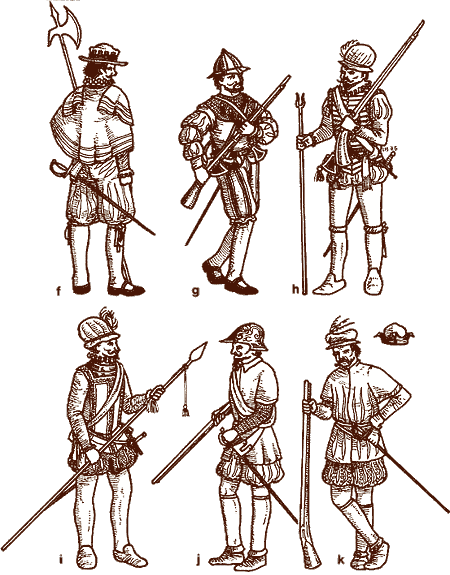
f. Guard halberdier, second half of the 16th Century. Colors probably red and yellow, g. Arquebusier of a Tercio, 1534. He wears an ornate morion, "gola de mala" (mail cape) and short, baggy leather jerkin, h. Musketeer, 1581. The velvet cap would later probably be replaced by a 'bowler' or felt hat. Later musketeers would also wear a bandolier. Note heavily tasseled flask, sash and musket rest
i. Officer, 1581, wearing corselet with embroidered cloth covering, velvet bag-type hat with narrow brim, stuffed and slashed breeches, and sash, j. Arquebusier, 1551, wearing tunic over mail shirt, sash and ornate burgonet. k. Arquebusier, 1551, with flat plumed cap with narrow brim, slashed tunic (probably leather) and slashed and embroidered breeches. Note manner of sword suspension, also shown in other drawings, and alternative cap which would be worn by some Spanish/Imperial arquebusiers a little earlier
A high proportion of this expeditionary force were crossbowmen, and there were still many sword-and-buckler men. The former were steadily replaced by arquebusiers and the latter, despite the striking success against pikes, by pikemen, who had some chance of standing in the open against cavalry. Infantry firepower—the first use of massed arquebusiers—combined with skilful use of field fortifications, was, however, the key to early Spanish success.
The troops were divided into "Colunelas" (columns) under "Coronels", at first of about 600 men in three "squadrons". In 1505, 20 Colunelas, of 1,000 to 1,500 men each, in four or five "banderas", were established. These were predominantly of pikemen and arquebusiers, but included a few halberdiers and up to perhaps 20 percent sword-and-buckler men.
The infantry still wore close fitting hose from the waist down, often with calf-high Moorish boots of red Morocco leather; a tunic with a very wide and long skirt might also be worn. Even an arquebusier could wear a plate corselet, but mail shirt, studded brigantine, or plain leather jerkin was a more usual type of protection. Nearly all seem to have had helmets, simple sallets, burgonets, or cabasset morions. Red was a popular color, and scarlet military cloaks are mentioned. A picturesque unit in Gonzalo's army was the negro guard of the field-treasury, clad in fuchsia-blue cloaks (there were field-forges, field-mills, and even traveling altars as well).
As in later years, the Spanish infantry were supplemented by mercenaries—mainly Italian skirmishers with arquebusses, and Germans with pike or arquebus. There was even a secret weapon, tried in 1512—from 30 to 100 war-carts on two wheels, carrying two or three heavy arquebusses, and a spear and a scythe-blade projecting in front. A five-foot trail-pole behind allowed for man-power propulsion. Apparently designed to break up infantry or cavalry attacks, these early tanks were presumably not successful, as they were used only once.
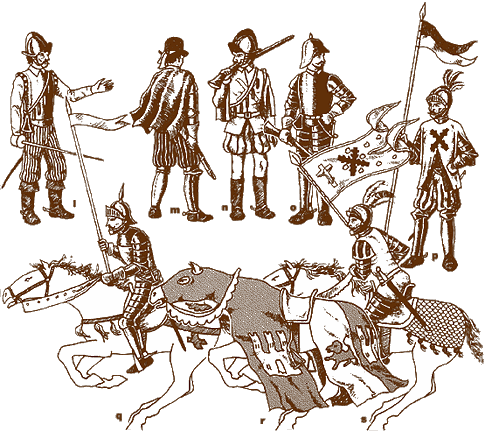
l. Caballo Coraza, early 17th Century. Corselet and morion. Sleeves yellow, shoulder pads red and yellow, breeches red and yellow. Boots, bandolier, gauntlets and harness all brown leather, m. Herreruelo, 1560. Leg and arm armour and corselet polished steel. Breeches black with red stripes. Cloak black, lined red. "Bowler" hat black with red ribbon and many holes, showing red lining, n. Mounted arquebusier, 1630s. Jacket yellow. Shoulder pads, undersleeves and cross red. Breeches blue with red stripes. Hose yellow and boots black. o. and q. Escopetero, 1508, and Caballo Ligero, 1493. 'o' has a black saddle edged red and red and yellow slashed breeches, 'q' has brown trousers and a red corselet cover.p. Man-at-arms, 1560. Yellow breeches, purple cassock with red lining, cross and helmet plume. Pennon red over yellow, r. Horse trappings of Old Guard of Castile, 1490s. Lion red on white (arms of Leon); castle yellow on red (arms of Castile). They are reversed on the opposite side. s. Standard bearer, 1525. Saddle, harness and tassels red. Saddle edged silver. Saddle cloth edged gold. Armour and scales, covering rear of horse only, polished steel. Plumes (from front) yellow-red-white. Standard white, with gold crucifix and red cross.
The Tercios
Emerging in the early 1530s, these were a new step in infantry organization, for the Spanish or any other European army—the first large permanent infantry units, both administrative and tactical, with territorial titles (the earliest were Lombardy, Naples, and Sicily) and enduring traditions and esprit de corps—they soon acquired nick-names too, such as "The lnvincibles" and "The Immortals". With the earlier Corunelas, they were the ancestors of all later regiments.
They were created by amalgamating existing Corunelas in threes (it may be this which gave rise to the name "Tercio", but it is likelier that it came from their resemblance to one of the three battles of earlier armies). This gave an organization of 12 companies of 258 men each, two being of arquebusiers only, the others of both arquebusiers and pikemen, giving a roughly 50:50 ratio of pikes to shot (rather advanced for its time).
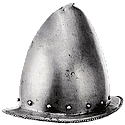
A Cabasset Morion,
16th Century
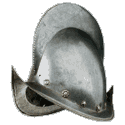
A Combed Morion,
16th Century
|
This basic set-up seems to have lasted through the 16th Century, with only two significant changes. The first was a decrease in the proportion of pikemen, which fell to 40 percent by the 1580s; the second, the introduction of the musket. This weapon was pioneered by the Spanish army, and seems to have appeared in the Tercios in the 1560s. At first, the proportion of musketeers in the Tercio was less than ten percent, but by the last decade of the century, Parma's army in the Netherlands is said to have had more musketeers than arquebusiers.
In the 17th Century the proportion of pikemen fell still further, to only 30 or sometimes even 20 percent, but the trend toward the musket, in sharp contrast with developments in other armies, appears to have been somewhat reversed, the proportion of musketeers sometimes being as low as ten percent, and not over 33 percent. It may be presumed that this was connected with the greater handiness of the lighter weapon. In any case, the proportions were always variable, as were company strengths.
The 17th Century saw a reduction in company size (in the 16th Century the average size was probably about 150) and an increase in number of companies, this being set at 15 to 20 in 1603, and officially fixed at 15 by an ordinance of 1632, which also abolished the arquebus-only companies. Actual strength probably fell; throughout our period the realities corresponded only very roughly with the paper strength and organization, Tercios of the 16th Century averaging closer to 1,500 than 3,000 men.
A Tercio was commanded by a Maestre de Campo, assisted by a "Sargente Mayor" and a small staff including a doctor, a Drum Major (i/c Signals), achaplain, and an honor guard of eight halberdiers (there may well have been a few halberdiers and sword-and-buckler men included among the Tercio pikemen as well, but they would not have formed over about five or ten percent of the pikes). Each company had four officers and NCOs, including a standard-bearer, plus a chaplain, a drummer and a fifer.
The photograph posed with model soldiers shows a typical early Tercio formation; the pikemen are massed centrally in a solid square (derived from the Swiss); there are four "mangas" (sleeves) of shot at the corners, linked by a thin screen on each face of the square, provided by the arquebus companies.
A rather clumsy formation, wasteful of manpower, it was nonetheless used until well into the 17th Century with considerable success, though in later years the mangas became broader and stronger, and the shot at the rear were omitted; one advantage over linear formations was its aptitude for all-round defense should a flank be turned. However, it did prevent the full use of firepower in one direction, and in the 17th Century Tercios did employ semi-line formations (though nine to 12 ranks deep) on occasion. The contemporary diagrams show some of the variations possible in battle and on the march.
The number of Tercios increased over the period, the Walloon and Burgundian troops being formed into Tercios around the end of the 16th Century; later ones included Portugal, Liege, Brabant, Flanders, Malaga, Sardinia and Armada (Marines), but there remained many troops, especially non-Spanish ones, whose Banderas were not organized into Tercios. These were usually formed into Colunelas or Regiments of varying size; one of Germans in 1536 was no less than 8,800 strong (20 bands)! This was exceptional, however; most had five to ten banderas, with a similar combination of arms to that of a Tercio.
Infantry Dress
That for the beginning of the period has already been described; style throughout was fairly uniform, following, or even setting, civilian fashion, the troops generally distinguishing themselves by richer dress—silver trimming was common. In the mid to late 16th Century short stuffed breeches were worn, doublets could also be padded; coats with hanging sleeves were often worn. Spanish and Burgundian troops were particularly characterized by the stiff white neck-ruff, which they wore longer than others, into the 17th Century. Longer, baggy breeches then became usual, often with red stockings; by mid-century the usual dress for an infantryman was a black felt hat with a kerchief round it, white linen shirt, dark brown doublet and breeches and a buff coat. There was, however, no uniform properly so-called before the later 17th Century—a document of 1610, indeed, remarks "Never was there a strict ruling on the costume and armament of the Spanish infantry, for it was this that raised the morale and dash that must possess the men of war".
The national distinguishing mark (shared with Imperial troops) was, first, the red cross (X), on back and breast, later, the red sash worn by officers, pikes and cavalry.
Musicians were more ornately dressed, and in the 16th Century wore small round caps and heavily-slashed clothing; by the mid-17th Century they had coat trim diagonally striped in the Hapsburg red and white. Officers sometimes carried gilt partisans or halberds, and had a shield carried before them by a page, even in battle.
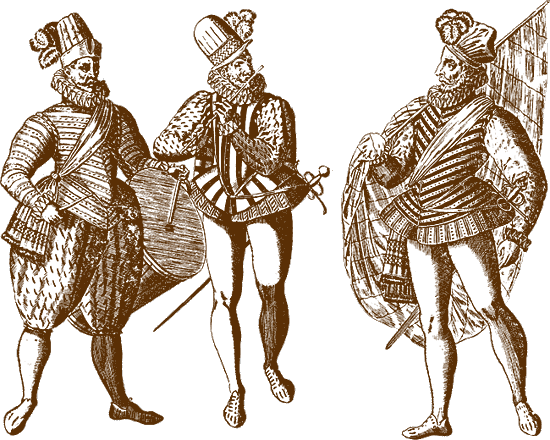
From left to right: Spanish drummer, fifer, and standard bearer of the late 16th Century
|
After the early 16th Century, only pikemen, halberdiers, sword-and-buckler men and officers were likely to wear plate armour—a corselet, often with gorget and armour for the shoulders, arms and thighs (at least half the Spanish pikemen were armoured). Armour could be blackened, but that of Alva's army (1567) is said to have been richly decorated and gilded. 16th Century arquebusiers often wore mail shirts or leather jerkins for protection; 16th Century musketeers, encumbered with their heavy weapon, its stand, bandolier, etc, wore no protection and usually affected a felt hat rather than the burgonets, morions, or caps of the other infantry.
The Cavalry
As already mentioned, the Spanish knights, like the Spanish infantry, were reorganized by Ferdinand and Isabella, becoming semi-regular, on the pattern of French and Burgundian "Bandes d'Ordon-nance". Their Catholic Majesties also somewhat lightened the man-at-arms' full armour, and introduced a rather handier "lanza d'Armas" in place of the very heavy medieval "Lanzon". They are also said to have abolished horse-armour, but some Spanish cavalry certainly retained this considerably later.
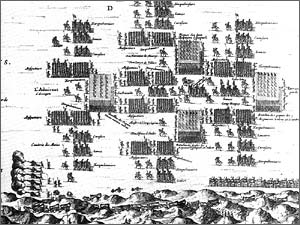
The Spanish army in order of battle, at Nieuport in 1600. Note large pike blocks (one made from two Tercios); various types of cavalry; and massive gun teams and limbers in the foreground. (National Army Museum)
|
In 1493 the "Old Guard of Castile" was created, originally 2,000 strong, in 25 companies of 80 men-at-arms, each having 20 light "Ginetes" (Genitors) attached. Each man-at-arms had two horses and a page that rode his turnabout horse and carried his lance. The Old Guard (who survived in reduced form to the 17th Century) wore "alwhyt" armour (uncovered, polished steel) with red plumes and the horse-trappings illustrated.
As well as the men-at-arms in Royal service, there were also the lances of the Military Orders, Grandees, Nobles, Prelates and of the wealthier inhabitants of Andalusia and Murcia. The Grandees and Nobles raised about 1,800 horse in the 1530s and 40s, of whom only a quarter were actually men-at-arms; the "Cavalry of Distinction" of Andalusia and Murcia may have reached 6,000, but only a small proportion of these would be men-at-arms, and most of these cavalry were of rather dubious quality in training and equipment. Many served only in Spain.
From 1519, Spain had also the Bandes d'Ordonnance of the Low Countries, some 3,000 excellent Burgundian "lances" in squadrons of 20.
During the Italian Wars, the Spanish also used a fair number of well-equipped but not over-enthusiastic Italian lances (Italian lances of the time including at least four men, one or two being non-combatant).
Spain always had some difficulty in maintaining many well-equipped men-at-arms; by 1505 there were actually only nine companies, totaling 1,050, and, though Philip II raised the total to 17 companies, these were reduced in 1560 to 50 each. The standard of their mounts and armour is said to have been below that of other nations, and in the later 16th Century they did not usually form more than about ten percent of the usual cavalry force. By that period they had lost horse armour but retained heavy full or three-quarter armour, heavy lance and mace, and still required two horses. In the 17th Century—officially from 1633—the men-at-arms lost their lances, their armour was reduced to morion and cuirasse, and they were armed with pistols and sword. In their new guise they were known as "Caballos Corazas".
Lancers
Up to 1512, most Spanish lighter cavalry were incorporated in the lances of the men-at-arms; they would have operated separately, and thereafter were organized separately, normally in cornets of 100 (up to 500 for a general's cornet), which could be grouped in provisional Trozos of 300 to 600, or in Tercios of 500 or more; these again could be grouped in regiments or brigades. Cornets, of lancers and arquebusiers at least, were recognizable by a cassock of unit color, worn over armour.
The lighter cavalry who tended to replace the men-at-arms were the lancers. Found in other armies (English demi-lances, for example) they were particularly characteristic of the Spanish, and continued to carry their lances through the first half of the 17th Century (though the lance itself became lighter).
They wore three-quarter armour, open helmets, and rode unarmoured horses, and by the mid-16th Century carried a pistol in place of the man-at-arms' mace.
Ginetes
These were the typical Spanish light cavalry of the 15th and early 16th Century. Dashing skirmishers, they carried the heart-shaped Moorish leather-covered shield, and used Moorish tactics—feigned retreats and so on. Gonzalo de Cordoba's army in 1495 had 500 genitors to a mere 100 men-at-arms. They could carry crossbows, but their chief weapons were sword and javelin. Some had plate armour, but most had mail shirt or brigantine, steel cap or morion, and odd bits of arm or leg armour.
Stradiots and Italians
Stradiots were first hired by the Spanish in 1507, and later considerable numbers of Italian light cavalry were also hired, at first with the crossbow, later with the arquebus.
Archers
There were mounted archers in the Bur-gundian Compagnies d'Ordonnance and in 502 a force of Archers of Burgundy was incorporated into the Spanish cavalry, as, apparently, a kind of Royal Bodyguard. They wore a plumed open-face burgonet, mail shirt, and some arm and leg armour, with a white surcoat bearing the red cross of Burgundy on front and back. They still, according to Soto, were armed as under Charles the Bold, with bow and two-handed sword (the latter being carried in a bowcase-cum-quiver on the right of the saddle), but the fact that the forequarters of their mounts were protected by a "clibano" decorated with the royal monogram might indicate that they were cavalry rather than mounted infantry, and one might suspect that a lance would also be carried.
Firearm Cavalry
Firearm cavalry or escopeteros appeared early in the Spanish army, and were first organized into separate bodies in the very early 16th Century.
The two chief types of the 16th Century were the Herreruelos and the Herguletiers (mounted arquebusiers). From the later Italian wars, they replaced the Ginetes.
The Herreruelos were armed with pistols and fairly heavily armoured, corresponding to the hired German Reiters and other cuirassier types, while the arquebusiers were lighter, only about half of them wearing corselets, the rest leather, and were armed with a longer-range weapon. They also operated on foot as well as mounted. Mounted, both could play a similar role, operating on the front or flanks of men-at-arms or lancers, preparing and supporting attacks with their fire, but the herreruelos would be more likely to charge in themselves. Both types carried swords, and arquebusiers sometimes carried a pistol as well as the arquebus (while in the 17th Century both Cuirassiers and Caballos Corazas could have arquebusses or carbines).
Dragoons first appeared in Spanish ranks in the 1630s, and tended to replace mounted arquebusiers in the 1640s and later. They were similarly armed but carried, beside sword and arquebus, a mace and a small pick which could be used to tether the horse while the rider operated dismounted. Their advantage as in other armies was cheapness; being mounted infantry rather than cavalry capable of acting dismounted, they could be worse-mounted than arquebusiers and required no armour. The early dragoons had a white slouch hat with a red feather, buff coat, calfskin gauntlets and boots, and breeches decorated with red slashes and piping.
Numbers
It is hard to fix the relative proportions of these cavalry types. Sir Roger Williams, referring to the second half of the 16th Century, says there were five lancer cornets to every one of herguletiers, but Spanish writers of similar but slightly later date suggest 25 percent lancers, 25 to 30 percent arquebusiers, and most of the rest cuirassiers, probably including both herreruelos and the German pistoleers hired in large numbers. The Spanish did not consider Germans very highly, but their horse were cheap and plentiful, and often formed from 25 to 40 percent of the Spanish cavalry from Charles V's times on. Indeed, one should remember that a large part of any Spanish army was usually non-Spanish—in 1588 the Duke of Parma's army of 60,000 men had only 18 percent Spaniards, whereas Germans and Walloons, in their own units, made up about a third of the army each! 12 percent were Italian, other nationalities the remaining five percent.
It is usually said, following Oman, that cavalry were a small proportion of Spanish armies. Certainly the infantry were the chief strength, and the observation may be true of the early Italian wars, but later the cavalry seem usually to have formed from a quarter to a third of the army—as strong a proportion as that of other nations.
Flags
Most infantry flags, and many cavalry ones, would be based upon the red cross of Burgundy, at least from 1519 on. It could be on a plain white background, or a checkered or striped one of green, black or blue and white, or be more elaborate like some of those illustrated. During the union with the Empire, Imperial eagles, sometimes bearing the arms of the Spanish provinces, could also appear, and the red-white-red horizontal stripes of the Hapsburgs are also likely. Religious subjects were also very usual, such as: red, with the Virgin in Glory in gold; blue, with the Virgin in Glory, moon, and stars, and the inscriptions "Ave Gratia Plena", "Stella Maris" and "Pulcher ut Luna"; or: Virgin on one side, Christ crucified on the other.
Commanders in chief had their own standards of guidon shape carried with them. That used by Don John of Austria in the Netherlands bore a crucifix, and the motto: In hoc Signo Vici Turcos, In Hoc Haereticos Vincam.
Infantry had the usual large square flags, lancers often long swallow-tail banners, other cavalry small square flags.

a. Cardinal Ximenes' flag, carried at the taking of Oran. White flag, dark shading, lines and tassels, Cardinal's hat red; light shading gold, b. Also 1509. Red cross and border on white, c. Cavalry flag, about 1600, showing the Virgin Mary. One possibility for this is a red flag and figure with gold rays, d. The old 'national' flag. Likely to be carried by Spanish in early 16th Century. Yellow castle on red (Castile), red lion on white (Leon), e. Carried by pikes at Pavia, 1525. Quarters as 'd' alternating with (probably) the four red pales on yellow of Aragon—which could also be carried on its own. f. Catalonia. Four red bars on yellow, g. Men-at-arms flag at Pavia. Probably yellow castles on red quartered with four red pales on yellow, tail of flag white, h. Cavalry flag at Pavia. Probably red crosses on white, and either red on white or red on yellow stripes; tail white
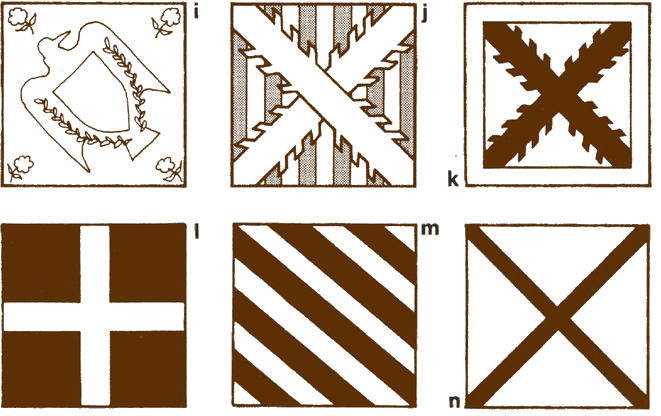
i. Mounted standard, 1503. Green flag, black eagle, rest gold, j. fled cross raguly, green and white stripes: late 16th or early 17th Century, k. Cavalry flag, probably 17th Century. Colors include red on white, gold on red or white on gold. l. Yellow cross on red. 1588. Used on ships, but I am not sure about land forces, m. 16th Century, red on yellow. Also seen on ships, n. Simplest form of 16th Century flag—red on white
About the Author
George Gush was educated at Tonbridge School, Kent, and won an Open Scholarship in History to Christ Church, Oxford, and has pursued a teaching career ever since graduation.
Acknowledgements
Article contents originally © Copyright George Gush and Patrick Stephens, Ltd 1975, 1982 and reproduced here with permission.
|
|

